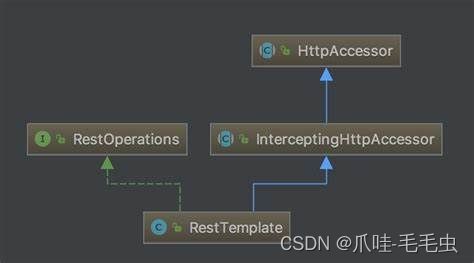http请求类RestTemplate
RestTemplate类
-
- 1.1 初识RestTemplate
- 1.2 注入方式
- 1.3 常用方法
1.1 初识RestTemplate
RestTemplate类是一个用于发送HTTP请求并获取HTTP响应的模板类。它可以被用于执行GET,POST,PUT,DELETE等各种HTTP方法,同时还支持处理请求参数、响应解析等一系列HTTP操作。
RestTemplate类可以被视为Java中的HTTP客户端,与Apache HttpClient、OkHttp等类似,但是它提供了更加方便的API和更好的集成性。

在Spring中,我们可以使用RestTemplate类在代码中发送HTTP请求,比如发送RESTful API请求获取数据、调用外部HTTP服务等等。可以通过构造函数或者使用RestTemplateBuilder类来创建RestTemplate对象,然后使用RestTemplate提供的方法来发送HTTP请求。
例如,以下是使用RestTemplate类发送GET请求的示例代码:
RestTemplate restTemplate = new RestTemplate();
String url = "https://api.example.com/data";
String response = restTemplate.getForObject(url, String.class);
在上面的代码中,我们创建了一个RestTemplate对象,然后使用getForObject()方法发送GET请求,并将响应体解析为String类型的对象。RestTemplate会自动处理HTTP请求和响应的细节,包括设置请求头、解析响应体等等。
除了getForObject()方法,RestTemplate还提供了其他一系列方法,例如postForObject()、put()、delete()等,用于发送不同类型的HTTP请求。RestTemplate还支持处理请求参数、响应解析等一系列HTTP操作,例如:
MultiValueMap<String, String> requestBody = new LinkedMultiValueMap<>();
requestBody.add("name", "John Doe");
requestBody.add("age", "30");
HttpHeaders headers = new HttpHeaders();
headers.setContentType(MediaType.APPLICATION_FORM_URLENCODED);
HttpEntity<MultiValueMap<String, String>> requestEntity = new HttpEntity<>(requestBody, headers);
ResponseEntity<String> responseEntity = restTemplate.exchange("https://api.example.com/user", HttpMethod.POST, requestEntity, String.class);
在上面的代码中,我们首先创建了一个请求体,然后设置请求头和请求实体,最后使用exchange()方法发送HTTP请求。exchange()方法可以发送任何类型的HTTP请求,并返回响应实体对象,其中包括响应头、响应体等信息。
总之,Spring的RestTemplate类为我们提供了一种方便、易用的方式来发送HTTP请求,并支持处理请求参数、响应解析等一系列HTTP操作。
1.2 注入方式
在Spring应用程序中,我们可以使用依赖注入(Dependency Injection,DI)来注入RestTemplate对象。具体的注入方式取决于你使用的Spring版本和应用程序的架构。

在Spring Boot应用程序中,我们可以通过在配置类中使用@Bean注解来创建和注入RestTemplate对象。例如:
import org.springframework.context.annotation.Bean;
import org.springframework.context.annotation.Configuration;
import org.springframework.web.client.RestTemplate;
@Configuration
public class AppConfig {
@Bean
public RestTemplate restTemplate() {
return new RestTemplate();
}
}
在上面的示例代码中,我们创建了一个名为restTemplate的RestTemplate bean,通过在@Configuration注解的类中使用@Bean注解,将其注册到Spring容器中。在其他组件中,我们可以使用@Autowired注解来注入RestTemplate对象,例如:
import org.springframework.beans.factory.annotation.Autowired;
import org.springframework.stereotype.Service;
import org.springframework.web.client.RestTemplate;
@Service
public class MyService {
private final RestTemplate restTemplate;
@Autowired
public MyService(RestTemplate restTemplate) {
this.restTemplate = restTemplate;
}
// rest of the service implementation
}
在上面的代码中,我们通过构造函数注入RestTemplate对象,并将其赋值给私有成员变量restTemplate。注意到我们使用了@Autowired注解来标记RestTemplate参数,这样Spring容器就会自动注入一个RestTemplate对象。
除了使用构造函数注入,我们还可以使用setter方法或字段注入的方式来注入RestTemplate对象。无论采用何种方式,都需要保证RestTemplate对象已经被正确创建并且已经被Spring容器注册。
1.3 常用方法
| 方法 | 介绍 |
|---|---|
| getForObject() | 发送一个HTTP GET请求并返回请求的响应体作为Java对象。 |
| getForEntity() | 发送一个HTTP GET请求并返回请求的响应体作为ResponseEntity对象,其中包含了响应头、响应状态码等信息。 |
| postForObject() | 发送一个HTTP POST请求并返回请求的响应体作为Java对象。 |
| postForEntity() | 发送一个HTTP POST请求并返回请求的响应体作为ResponseEntity对象。 |
| exchange() | 发送一个HTTP请求并返回请求的响应体作为ResponseEntity对象,可以支持所有HTTP方法。 |
| execute() | 发送一个HTTP请求并返回请求的响应体作为Java对象,可以支持所有HTTP方法。 |
| headForHeaders() | 发送一个HTTP HEAD请求并返回响应头。 |
| optionsForAllow() | 发送一个HTTP OPTIONS请求并返回响应头中Allow字段的值。 |
除此之外,还有一些支持HTTP请求和响应处理的其他方法,例如添加HTTP头信息、发送文件、下载文件等。